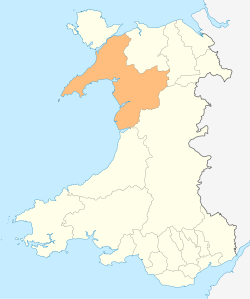| Llanegryn | |
|---|---|
 Lower road into Llanegryn in 2009 | |
Location within Gwynedd | |
| Population | 303 |
| OS grid reference | SH600054 |
| Community |
|
| Principal area | |
| Preserved county | |
| Country | Wales |
| Sovereign state | United Kingdom |
| Post town | TYWYN |
| Postcode district | LL36 |
| Dialling code | 01654 |
| Police | North Wales |
| Fire | North Wales |
| Ambulance | Welsh |
| UK Parliament | |
| Senedd Cymru – Welsh Parliament | |
Llanegryn is a village and a community in Gwynedd, north-west Wales. It was formerly part of the historic county of Merionethshire (Welsh : Meirionnydd, Sir Feirionnydd). It is located within Snowdonia (Eryri) national park, south of the mountain range of the same name. Travelling by road, it is around 4 miles (6 km) north-east of Tywyn and 17 miles (27 km) south-west of Dolgellau. The nearest railway stations are at Tonfanau and Llwyngwril, both less than 3 miles (5 km) away.
Llanegryn is named for St Egryn, with llan meaning church or parish – a common feature in Welsh place names. The village lies in the Dysynni Valley (Dyffryn Dysynni).


